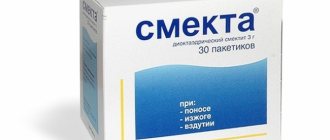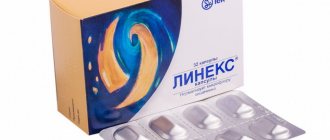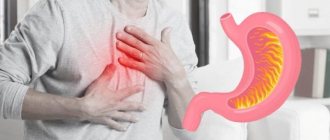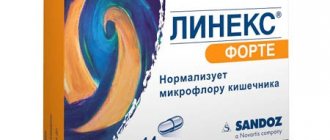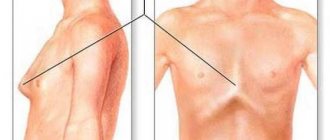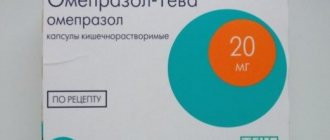Linex is also prescribed for the prevention of dysbacteriosis. It is indicated for antibiotic therapy, chemotherapy, it is recommended to take it after operations, if it is impossible to eat properly, to prevent “travelers' diarrhea” during a move or summer vacation.
Since the lactic acid bacteria that make up the drug are resistant to antibiotics, these drugs can be prescribed simultaneously.
Often, intestinal dysbiosis occurs in newborns in the first months of life. The baby becomes restless, eats poorly, and does not sleep at night. His stomach is swollen and painful. The stool may be green in color, with mucus and an unpleasant odor.
Composition of Linex
Any reference book will contain information about whether the medicine belongs to group K63.8.0. This is of interest, because Russian sources classify dysbacteriosis as a member of the K59.9 subgroup. Each group includes a large number of drugs aimed at eliminating a specific pathology. Approximate composition (without excipients) of the drug Linex:
- Bifidobacterium infantis strain.
- Lactobacillus acidophilus strain.
- Enterococcus faecium strain.
The bottle contains lactobacilli, bifidobacteria and enterococci, three common families of intestinal cultures.
Therapeutic effect
The action of Linex is due to the characteristics of lactic acid bacteria that are part of it. After the destruction of the gelatin capsule in the gastrointestinal tract, they begin to colonize different parts of the intestine, normalizing its flora. Here's what these microorganisms do:
- By fermenting lactose, they increase acidity in the intestines. An acidic environment activates digestive enzymes and prevents the growth of pathogenic bacteria.
- Stimulates the production of B vitamins and vitamin K.
- They take part in the exchange of bile acids and enzymes.
- Prevents the attachment of pathogenic bacteria to the intestinal wall.
- Substances that have a bactericidal effect against pathogens are released into the intestinal lumen.
- Activate immune defense and the synthesis of secretory antibodies in the gastrointestinal tract.
The effectiveness of Linex is ensured by the high content of lactic acid bacteria. One capsule contains approximately 1.2×10⁷ microorganisms.
After entering the intestines, their number begins to increase exponentially. This allows you to normalize the intestinal flora and creates competition for pathogenic microbes. The drug is not absorbed into the blood and acts exclusively in the intestinal lumen.
Lactobacillus acidophilus
Bacteria are used to produce acidophilus and are actively used as part of other drugs for the treatment of dysbacteriosis. The bacterium is common among normal microflora; the main feature is the ability of lactobacilli to decompose lactose to lactic acid. By regulating the pH factor, the proliferation of pathogenic strains is greatly suppressed.
Lactose is milk sugar, a conglomerate of the simplest carbohydrates - galactose and glucose. Linex already contains lactose in its composition, in small quantities. Therefore, it is not forbidden to drink the contents with milk to achieve the full effect.
Lactobacilli are destroyed by heat or direct sunlight. By increasing the acidity of the environment, microorganisms suppress pathogenic life forms:
- Proteas.
- Staphylococci.
- Enteropathogenic Escherichia coli.
Clinical trial results are published regularly by the Mayo Clinic. The positive effectiveness of the strain varies from zero to maximum readings. The bacillus works against some vaginal infections. Regular intake of yoghurts with Lactobacillus acidophilus reduces the frequency of diarrhea in children and causes positive changes in the blood of patients with small intestinal dysbiosis. But most importantly, it helps people with lactose intolerance digest lactose. This includes most adults.
A surprise was the possibility of using these bacteria to combat cardiovascular diseases. The research needs further clarification.
Bacteria allow people suffering from flatulence to eat specific yogurt. Patients will experience benefits when taking Linex for obvious reasons - the building material is intended for bacteria. Possible contraindications. There is a risk of bacteria entering the blood, which is undesirable. People with:
- Central venous catheters.
- Diseases of the heart valves.
- Short bowel syndrome.
- Weakened immunity.
Linex should be given to premature babies with caution.
How to use?
You should take the medicine after consulting a doctor. The specialist will select the required dosage and duration of therapy. It is recommended to consume after meals with plenty of water. Children often do not swallow the capsule, so it is worth pouring the contents into a spoon and stirring with liquid.
The duration depends on the cause. According to the instructions, the selection is based on the patient’s age. For clarity, the information is presented in the table.
| Age | Number of capsules per day |
| Children under 2 years old | 3 |
| From 2 to 12 | 3–6 |
| Over 12 and adults | 6 |
It is recommended to take Linex for a course of treatment for dysbiosis for 2 weeks. When adding a drug to a complex with other therapy, the duration varies.
When taking capsules, it is prohibited to drink them with alcohol or any kind of hot drinks. The patient must seek help if:
- prolonged diarrhea for more than 2 weeks;
- sudden decrease in body weight;
- dehydration, which is accompanied by constant thirst, increased blood pressure, dry skin;
- blood or mucus in stool;
- severe abdominal pain;
- diabetes mellitus or other immunodeficiency condition.
To eliminate dysbiosis, Linex is combined with prebiotics. This drug includes Hilak Forte.
Bifidobacterium infantis
The mentioned gram-positive bacteria are present in the human gastrointestinal tract, being one of 32 species of the genus Bifidobacterium. They are resistant to air in small portions and are considered early colonizers of the mucous membranes of newborns. When grown in an anaerobic environment, they form shiny, convex white colonies. Infantis are present in small numbers in the adult gastrointestinal tract, are considered part of the intestinal flora, and produce lactic acid, the main purpose of bacteria to prevent the growth of pathogens. Infantis are non-pathogenic and are often added to foods.
Since 2002, the species has been part of longum, although previously it was classified as a separate group. The fusion occurred due to numerous similarities between DNA and 16S RNA gene sequences. Coincidences are observed in 97% of cases. The appearance is similar; in a joint colony, the observer is unable to identify a separate phenotype. Probiotic activity varies among the three species included in longum, and debate about the distinction continues.
Bifidobacteria make up the lion's share of the intestinal biota. To the surprise of scientists, some longum strains have been discovered that have high tolerance to the acidity of gastric juice and bile. These representatives are able to survive movement through the gastrointestinal tract (when consumed orally) and colonize the lower large and small intestines. Resistance is explained by the linked structures of glycoproteins and bacterial polysaccharides. The latter have strong electrostatic charges, causing adhesion to the epithelium.
The bond strength is enhanced by fatty acids (lipoteichoic acid). Infantis eat a varied diet and break down oligosaccharides. Bacteria ferment the gum, exhibiting a unique quality compared to other organisms. Bacteria complete the decomposition of amino acids with the help of special enzymes; unlike the previous group, they do not need to be fed with lactose.
Longum is used in the form of live bacteria to treat ulcerative colitis. The technique is patented. Used to regulate the immune system. The ability of bacteria to reduce the duration and severity of symptoms associated with colds and flu was unexpected.
What does it help with?
The drug helps cope with the symptoms of dyspepsia:
- pain;
- nausea;
- vomiting;
- bowel disorders - constipation, diarrhea;
- increased gas formation;
- bloating.
Such symptoms often accompany acute and chronic diseases of the digestive system, biliary tract, and gallbladder:
- dysbacteriosis;
- colitis;
- irritable bowel syndrome;
- stomach and duodenal ulcers;
- gastritis;
- biliary dyskinesia;
- duodenitis;
- reflux disease (esophagitis);
- flatulence.
Other indications for use are:
- allergic diseases and hemorrhoids;
- taking antibiotics and other drugs that inhibit the growth of beneficial microflora;
- condition after chemotherapy, radiation.
Note! The drug is contraindicated in case of intolerance to dairy products and hypersensitivity to the ingredients included in the drug.
The medicine can be taken:
- infants;
- women during pregnancy and breastfeeding;
- elderly patients;
- persons with chronic diseases.
Special Recommendations
Many patients try to take Linex for dysbiosis on their own. The medicine is sold in pharmacies without prescriptions, so buying it is not a problem. It is almost impossible to overdose on the drug, and side effects are extremely rare; it is quite safe. But the problem arises from the fact that without a correct diagnosis, you can develop a disease in which probiotic treatment is either not very effective or completely useless. Particular attention should be paid to the following symptoms:
- Temperature above 38 degrees.
- Blood and large amounts of mucus in the stool.
- Diarrhea that lasts more than 5 days.
- Symptoms of dehydration (dry mucous membranes and skin, weight loss).
- Severe abdominal pain.
If these signs appear, you should immediately go to the doctor. The medicine should be taken with caution for chronic diseases such as diabetes mellitus, hypertension, CHD, HIV infection and other immunodeficiency conditions.
Source: GastroZona.ru
Treatment regimen for dysbiosis
Linex® is a relatively new drug used for the treatment and prevention of intestinal dysbiosis at any age. Patients can use the medicine safely as the medicine is harmless.
To achieve the desired results from the medicine, you must consult a doctor. He will prescribe tests to identify dysbiosis. Further individual therapy, the amount of medication used and the treatment regimen will depend on this.
Treatment:
- the capsule is intended for internal use;
- The drug is taken after meals.
| Age | How many capsules to drink per day |
| Children under 2 years old | 3 pcs |
| From 2 to 12 years | 3-6 pcs |
| From 12 years and adults | 6 pcs |
It is recommended to take the tablet with a large volume of liquid. It is strictly prohibited to use hot and alcoholic drinks for these purposes.
The importance of beneficial microflora
The human body is inhabited by millions of different bacteria. Most colonize the gastrointestinal tract. The entire biocenosis is in balance with each other. Beneficial ones prevail, reducing the activity and growth of opportunistic pathogens. The value of normal microflora:
- takes part in the digestion of food;
- helps in the synthesis of vitamins (K);
- participates in the inactivation of a number of enzymes;
- affects the rate of red blood cell renewal;
- affects the circulation of bile acids.
In the gastrointestinal tract, flora actively colonizes the mucous membranes. In a healthy person, it is represented by bifidobacteria and lactobacilli. A newborn baby has a sterile intestine for the first 20 hours. Then active settlement begins for 2–4 days. Complete stabilization of normal flora in children occurs up to 2 years. In an adult, the composition usually differs due to the nature of the diet.
In breastfed infants, lactobacilli predominate in the intestines. Against the artificial background, bifido predominates. Normal Escherichia coli and a number of enterococci are also found.
Description of the drug
The drug contains beneficial bifidobacteria
Linex is a drug that includes compounds of various bifidobacteria, non-pathogenic enterococci and lactobacilli. When it acts on a small organism, the drug recognizes the characteristics of ongoing indigestion, identifies the causes of dysbiosis and has a beneficial effect, softening painful sensations and completely eliminating them.
The drug has the ability not only to neutralize painful discomfort in the stomach, but also to cure dysbiosis in a short period of time.
Linex stimulates the elimination of allergic reactions, helps improve weakened immunity, restores microflora in the stomach and normalizes the digestion process.
In addition, the medication helps reduce the baby’s body’s susceptibility to the effects of infectious pathogenic bacteria.
Linex is sold in a package that contains 10 sachets. Each stick contains 1.5 grams of medicinal powder. The internal content of the active component can be either snow-white or speckled, and also have a dull gray tint.
Linex belongs to the group of third generation drugs. It contains the following components:
- Lactobacillus acidophilus - these substances are often located in the human intestines. They prefer an acidic pH environment, which causes the bacteria to stimulate the production of such acidity in the intestines. The process is carried out due to the removal of lactic acid, which provokes the elimination of pathogenic bacteria sensitive to high acidity.
- Enterococci - they are in the digestive tract of any person. They promote active fermentation without causing the release of gases. They have increased endurance, which helps in the fight against pathogens.
- Bifidobacterium - helps to establish an acidic environment in the intestines.
Excipients are additionally added to the main active components. They help enhance the activity of the main ingredients. These substances are represented by the following composition:
- titanium dioxide;
- gelatin;
- Magnesium stearate.
Methylhydroxybenzoate and propylhydroxybenzoate are also present in small amounts.
Contraindications and side effects
Linex has virtually no side effects. Some patients may experience individual sensitivity to one of the components of the drug. In such cases, a rash on the body and hives may occur. If allergy symptoms appear, you should stop taking the drug and take antihistamines.
Since it contains lactose, the medicine should not be prescribed to patients with a deficiency of the enzyme that breaks down milk sugar (lactase). Linex is also contraindicated for people with rare hereditary galactose intolerance (galactosemia).
Since the medicine is safe and does not adversely affect the body of the mother and fetus, it can be prescribed to pregnant women. There are also no contraindications for use while breastfeeding. But in such cases, be sure to consult a doctor before prescribing.
Rules for the treatment of intestinal candidiasis
Treatment of intestinal candidiasis is currently a complex problem. This is due to the increasing resistance of fungi to drugs. The likelihood of obtaining positive results is reduced due to the development of thrush against the background of concomitant pathology. If it is not diagnosed and treated promptly, it is difficult to get rid of yeast in the intestines. The situation will worsen as the intestines become a source of fungi spreading to other organs. From it, candida gets onto the skin, into the vagina, and other systems.
Since yeast fungi are conditional pathogens, they coexist for a long time in symbiosis with normal intestinal microflora without causing painful symptoms. Under the influence of external or internal provoking factors, active reproduction begins, causing the accumulation of fungal mass. Toxins and waste products are absorbed into the blood. This allergizes the body and leads to intoxication. Oligosaccharides, as an integral component of the fungal cell wall, reduce the activity of the immune system. At this stage, non-invasive candidiasis develops.
With significant suppression of the immune system, candida penetrates the epithelium of the intestinal wall, destroying it. Invasive candidiasis occurs.
The fungus spreads through the blood throughout the body and affects the liver, pancreas, heart, and lungs. This is visceral candidiasis.
Therefore, it is important to begin treatment of intestinal candidiasis at the first clinical signs to prevent its further progression. For this, complex therapy is used, which includes a diet and several groups of drugs:
- antimycotics that act directly on fungi,
- probiotics that restore normal intestinal microflora,
- immunomodulators that activate the body’s defenses to fight the fungus,
- symptomatic treatment (antispasmodics, motor stimulants and others).
Every point in the treatment plan is important and cannot be ignored. The combination of Linex and Fluconazole is important. Specific medications are prescribed by the doctor individually. To normalize dysbiosis, the best and most famous drug in the world is Linex. For adults, it is used in capsules, known as Linex and Linex Forte. There are special forms for children - drops and powder (1.5 g sachets). The dose and duration of the course usually depends on the prevalence and severity of the process. In standard situations, the drug is prescribed from 12 years of age, 2 capsules three times a day with or after meals. Binding to food is important: this reduces contact with gastric juice, although the drug is considered acid-resistant, and the bacteria do not lose their properties after passing through the stomach.
Treatment of Candida in the throat and mouth
Newborns, children under one year old and the elderly are most susceptible to candidiasis of the throat and oral cavity. Mostly, the pathology occurs in patients with the following diseases:
- diabetes,
- removable dentures,
- positive tests for HIV,
- long-term use of inhaled hormonal drugs,
- diseases requiring antibacterial therapy.
In people with high immunity, pathology with such localization does not occur.
Treatment requires the use of local and general treatment:
- antifungal creams, ointments and tablets (Fluconazole, Clotrimazole),
- probiotics (Linex, Linex Forte),
- rinsing with antiseptics (Chlorhexidine, Lugol's solution, potassium permanganate),
- antihistamines (Loratadine, Zodak),
- immunomodulators (Echinacea, Immunoris).
Linex, as in cases of fungal infection of other organs and systems:
- acts as a probiotic drug that indirectly affects the fungus,
- improves immunity, helping to reduce treatment time and increase its effectiveness.
It is used for a long time, the dosage for an adult is 2 capsules three times a day. During treatment, you must follow all the rules of admission:
- take the drug only with or after food,
- drink with a sufficient amount of liquid at room temperature (at least 100 ml),
- exclude alcoholic drinks,
- stick to a diet,
- do not interrupt treatment when subjective improvement occurs.


